Overview
This article presents a comprehensive comparison of greenfield and brownfield sites, emphasizing their distinct advantages and challenges in the realm of development.
Greenfield sites are characterized by:
- Design flexibility
- Lower initial costs
- Expedited development timelines
In contrast, brownfield sites offer:
- Valuable opportunities for urban revitalization
- Mitigation of urban sprawl
- Leverage of existing infrastructure
However, these advantages come with the challenges of:
- Higher remediation costs
- Regulatory hurdles
Understanding these factors allows stakeholders to make informed decisions tailored to their specific project needs.
Introduction
The debate between greenfield and brownfield sites is increasingly relevant as urban landscapes evolve and land scarcity intensifies. Each site type presents unique opportunities and challenges that significantly impact development strategies in energy and infrastructure projects.
- Greenfield sites offer the allure of untouched land and design flexibility.
- Brownfield sites promise the revitalization of urban areas and potential economic incentives.
However, the pressing question remains: which option truly delivers the best long-term value and sustainability for developers and communities alike? Exploring this comparison reveals critical insights that can guide decision-making in an ever-changing real estate landscape.
Define Greenfield and Brownfield Sites
Greenfield locations represent undeveloped lands that have never been constructed upon, typically showcasing natural landscapes such as fields, forests, or agricultural areas. These sites offer a blank canvas for building endeavors, providing significant design flexibility and generally facing fewer regulatory hurdles. However, environmental assessments and regulations can complicate greenfield projects, potentially impacting speed to market.
Conversely, previously developed areas may contain pollutants or be underutilized, often situated in urban environments. Redeveloping these sites requires remediation efforts and can involve complex legal and environmental considerations. Notably, redeveloped facilities often incur lower capital expenditure costs due to existing utility infrastructure, making them advantageous for certain projects.
As land prices continue to surge—evidenced by a 130% increase in German cities since 2006—and urban sprawl persists, understanding the greenfield and brownfield site comparison is essential for stakeholders in energy and infrastructure initiatives. This understanding is particularly critical as they make informed decisions regarding location selection and development strategies, especially in light of the growing trend toward brownfield redevelopment as a means of urban regeneration.
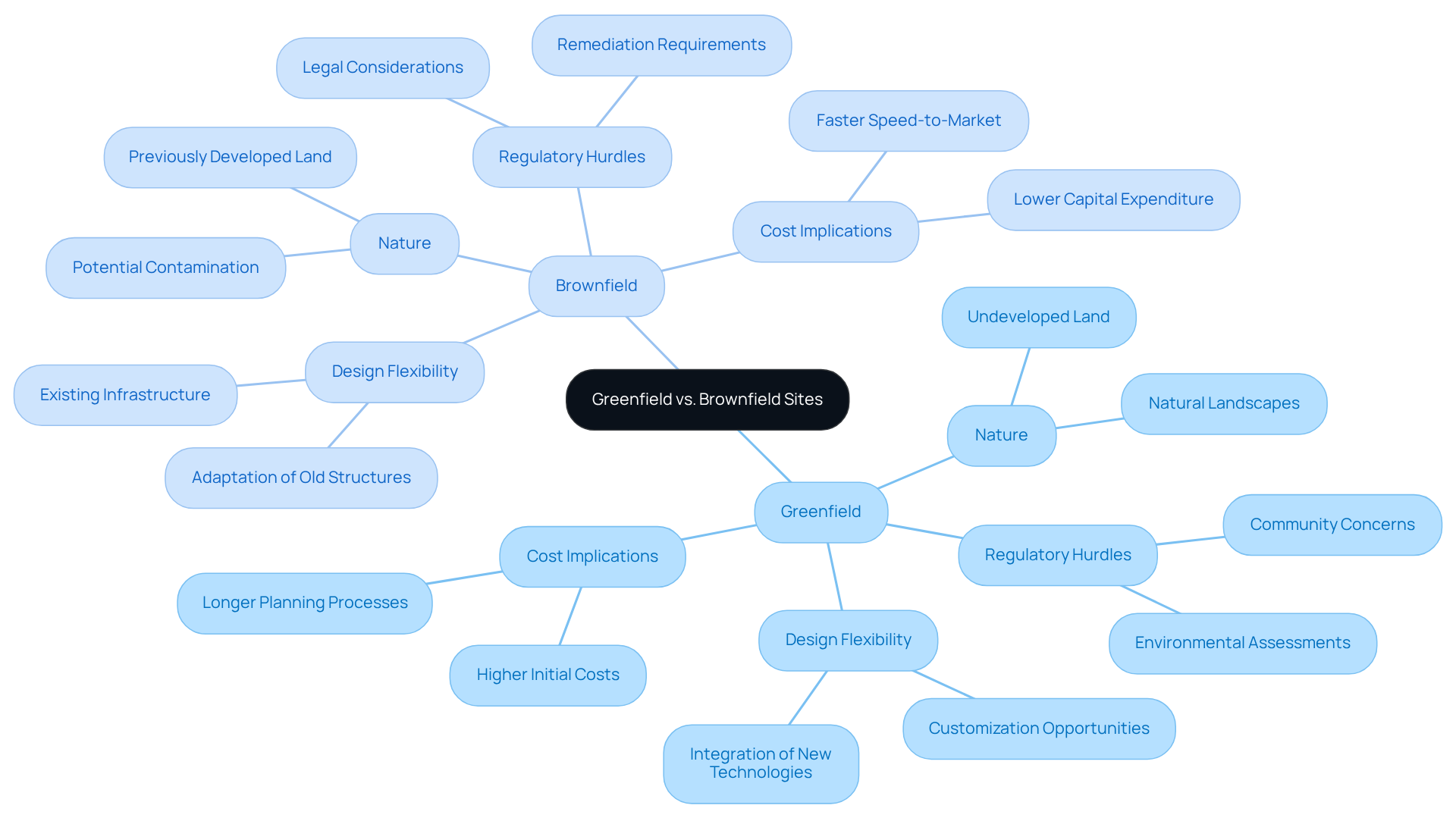
Explore the Advantages of Greenfield Sites
Greenfield sites offer compelling advantages for developers, particularly in energy and infrastructure projects. These sites are increasingly attractive due to several key factors:
-
Design Flexibility: Developers benefit from the freedom to design layouts and structures without the constraints of existing buildings or infrastructure. This flexibility fosters innovative designs tailored to specific needs.
-
Reduced Initial Expenses: A greenfield and brownfield site comparison typically shows that greenfield locations do not require extensive remediation, significantly lowering upfront costs compared to brownfield sites, which often involve costly cleanup efforts.
-
Accelerated Development Schedules: With fewer regulatory hurdles and no need for environmental restoration, projects on undeveloped sites can be completed more swiftly, addressing the urgent demand for new infrastructure. Notably, data center development usually spans about 7 years, comprising 4.8 years for pre-construction and 2.4 years for construction, making the speed of new projects particularly advantageous.
-
Access to Modern Infrastructure: Developers can incorporate the latest technologies and sustainable practices from the beginning, enhancing operational efficiency and reducing long-term expenses. This consideration is vital as energy costs increasingly pose strategic risks for organizations, especially given that data centers are expected to account for 8.6% of U.S. electricity demand by 2035.
These benefits position greenfield sites as a preferred choice for new developments, especially in rapidly growing markets where infrastructure needs are pressing. Urban planners acknowledge that such projects not only invigorate local economies through job creation, infrastructure enhancement, and increased tax revenue but also foster community growth by delivering essential services and amenities. However, it is crucial to address potential environmental concerns linked to new development, such as habitat destruction, pollution, greenhouse gas emissions, and the strain on natural resources.
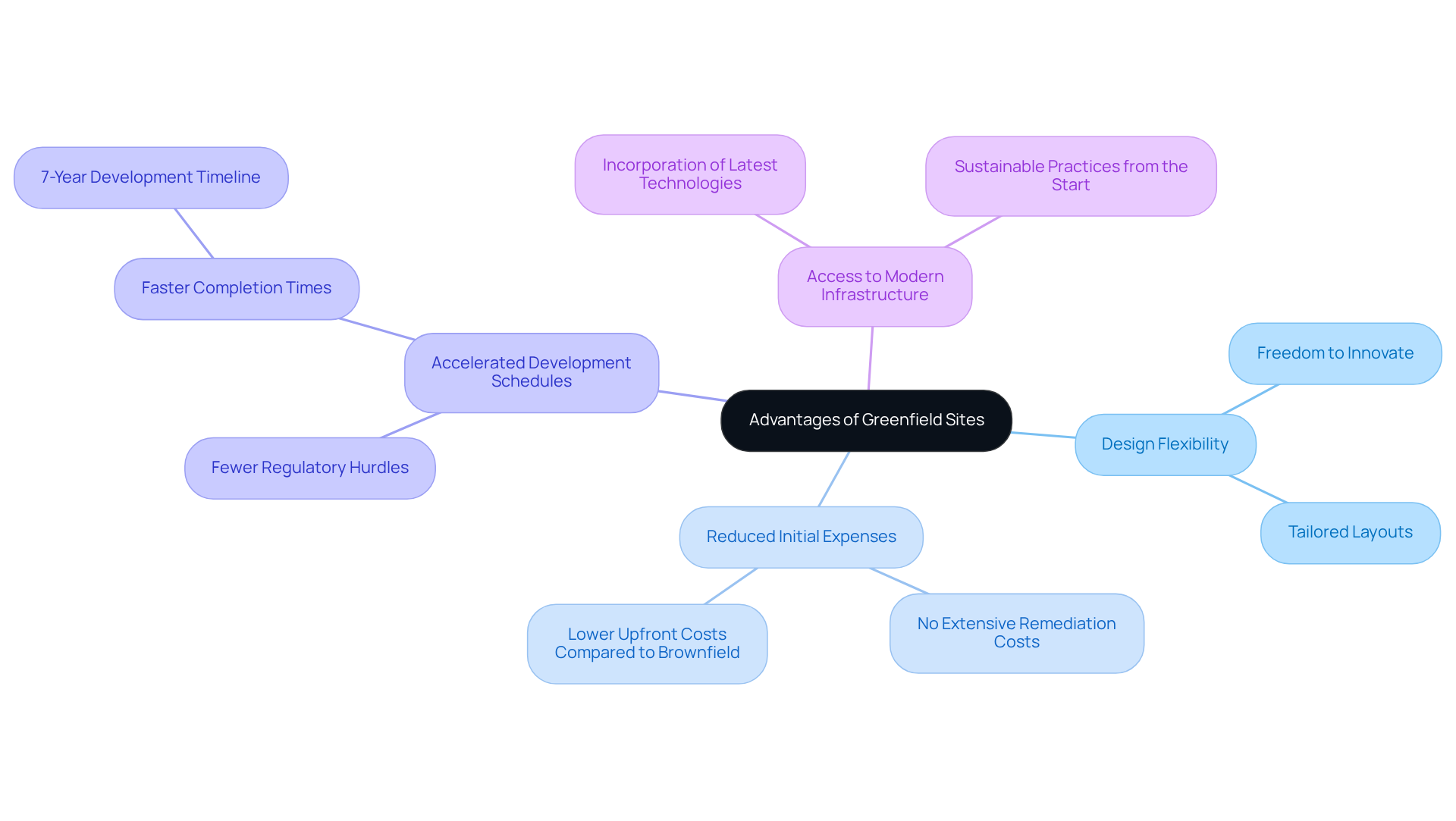
Examine the Disadvantages of Greenfield Sites
While greenfield sites present certain advantages, they are accompanied by significant disadvantages:
-
Environmental Impact: Developing on previously untouched land can result in habitat destruction, loss of biodiversity, and increased carbon emissions. Moreover, valuable farmland may be sacrificed to urban development, raising critical concerns about food production and ecological balance.
-
Infrastructure Expenses: Greenfield locations are often positioned far from urban centers, necessitating substantial investment in infrastructure such as roads, utilities, and services. Interestingly, while undeveloped areas may appear less expensive to build on, they can incur costs related to environmental restoration. For context, the total investment cost for a brownfield industrial park is approximately 5.92 million Euro, underscoring the potential cost advantages of greenfield sites.
-
Regulatory Challenges: New developments frequently encounter opposition from environmental groups and local communities concerned about urban sprawl and ecological preservation. This resistance can complicate the execution of initiatives and require additional planning efforts.
-
Longer Approval Processes: Depending on the location, obtaining the necessary permits and approvals can be a protracted process, potentially delaying timelines. Notably, the return on investment for new industrial parks in the East Slovak region reached 9.5%, highlighting the financial viability of these projects despite inherent challenges.
These challenges necessitate meticulous planning and consideration for developers choosing greenfield locations for their projects. As Paul B Tchounwou articulated, 'the implementation of industrial park investment projects is a constantly debated issue, particularly in the context of greenfield and brownfield site comparison,' thereby emphasizing the importance of strategic decision-making.
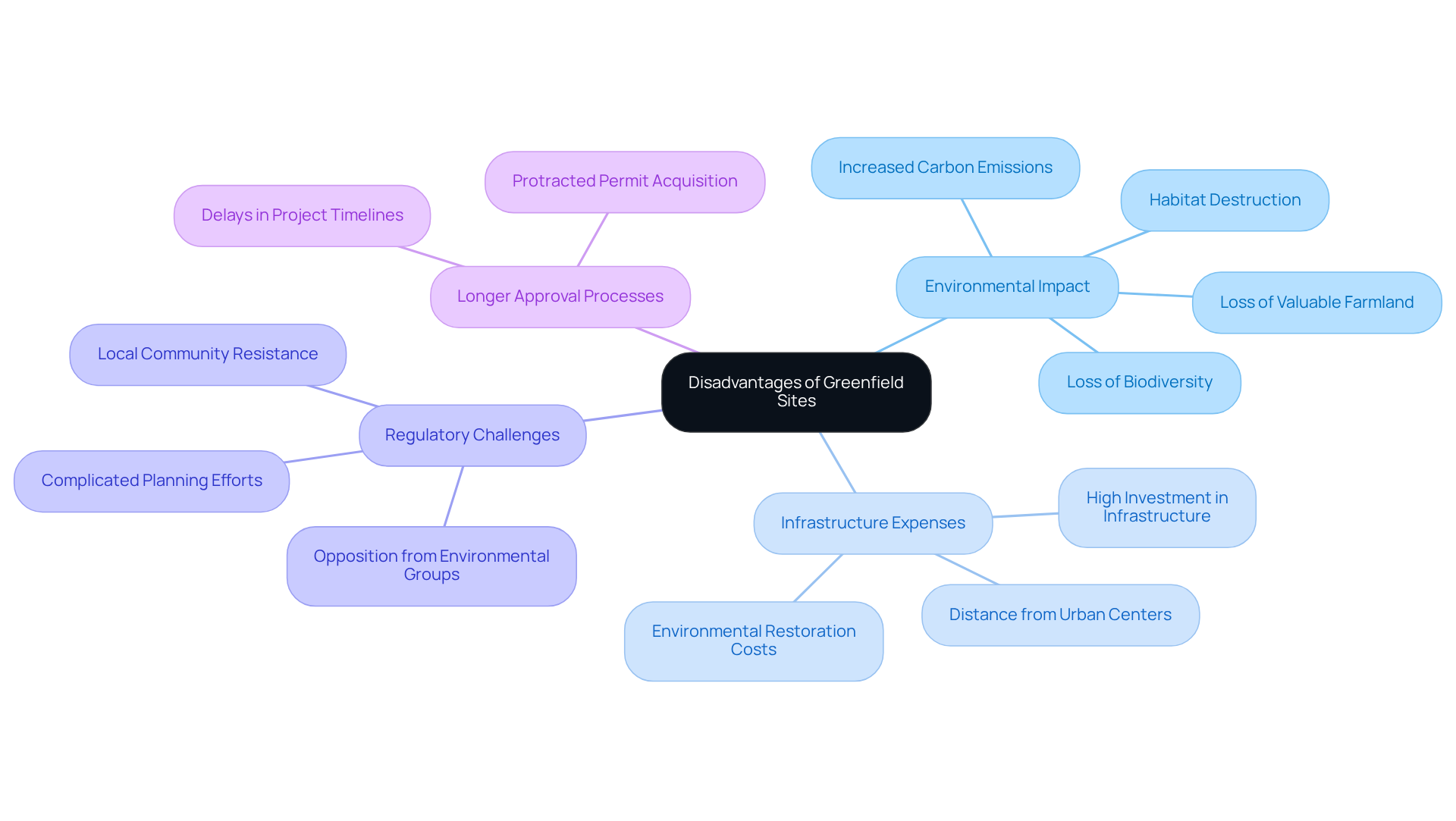
Identify the Benefits of Brownfield Sites
Brownfield sites offer significant advantages that play a crucial role in urban revitalization.
-
Urban Revitalization: Redeveloping contaminated properties can breathe new life into underused urban areas, enhancing local economies and improving community aesthetics. Successful transformations, such as the South Waterfront area in Portland, Oregon, exemplify how collaborative initiatives can turn polluted sites into vibrant mixed-use developments.
-
Minimized Urban Expansion: By repurposing existing locations, these projects curtail the encroachment into undeveloped regions, thereby safeguarding natural landscapes and ecosystems. This strategy not only protects valuable habitats but also fosters sustainable urban growth. Notably, construction on previously utilized land results in a 32 to 57 percent reduction in vehicle miles traveled compared to undeveloped land, contributing to lower pollution emissions.
-
Access to Infrastructure: Many redevelopment sites are strategically located in urban centers with established infrastructure, minimizing the need for new construction and associated costs. This accessibility can yield substantial savings for developers and expedite project timelines.
-
Government Incentives: Redeveloping contaminated land frequently qualifies for various federal and state incentives, grants, and tax credits. For example, every $100,000 of EPA brownfields funding generates approximately 10.3 jobs, underscoring the economic potential of these initiatives. Furthermore, the tax revenue generated after cleanup can be 2 to 7 times greater than the initial EPA investment, enhancing the financial allure for developers. Additionally, restoring contaminated properties can lead to residential property value increases of 5 to 15.2% within 1.29 miles of these sites, illustrating the economic benefits for local communities.
-
Environmental Benefits: Brownfield redevelopment also advances environmental sustainability, with studies showing a reduction in stormwater runoff by 47 to 62 percent. This not only assists in managing urban water systems but also enhances overall environmental quality.
These compelling advantages position previously developed locations as a strategic choice for energy and infrastructure projects, particularly in urban areas where space is limited.
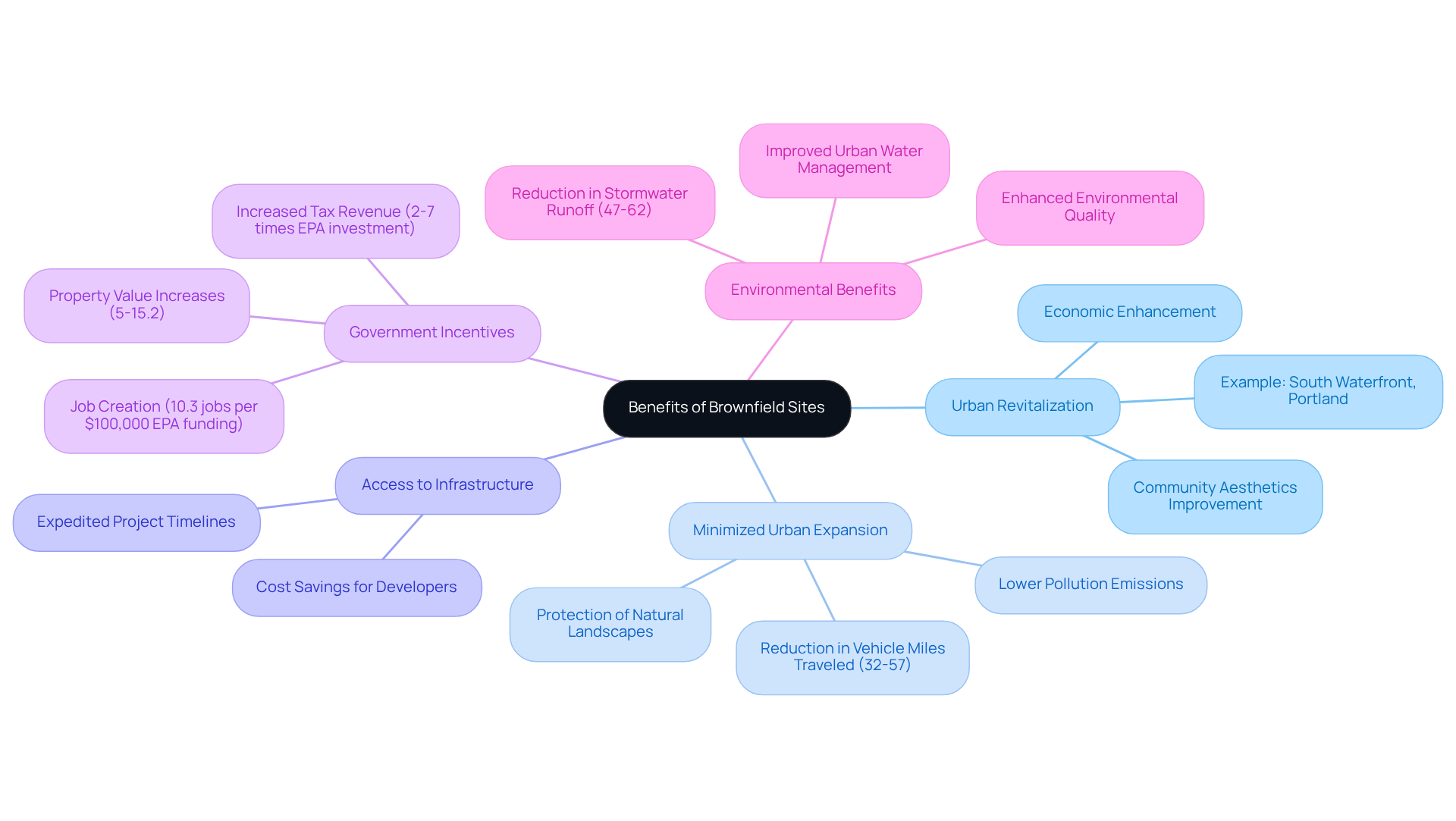
Assess the Challenges of Brownfield Sites
The challenges presented by brownfield sites, despite their numerous advantages, are highlighted in the greenfield and brownfield site comparison.
-
Environmental Remediation: Cleanup is often extensive, as hazardous materials must be removed from previously developed locations. The average cost of remediation is estimated at $602,000, which can impose a substantial financial burden on developers. However, the average benefit value per contaminated land stands at $3,917,192, underscoring the economic viability of remediation efforts.
-
Regulatory Hurdles: The complex legal and regulatory framework surrounding contaminated land redevelopment complicates projects. Developers must contend with liability concerns and comply with various environmental laws, which can delay progress and inflate costs. For instance, the intricacies of liability agreements can deter investment in these locations.
-
Public Perception: Communities often harbor skepticism towards redevelopment projects, driven by fears of contamination and associated health risks. Notably, over 40% of public health assessments conducted by ATSDR identified risks to public health. This reality necessitates proactive communication and community engagement strategies to build trust and garner support for redevelopment initiatives.
-
Higher Initial Costs: Although previously developed sites can yield long-term economic advantages, the initial expenses tied to cleanup and regulatory compliance frequently exceed those of undeveloped sites. Developers must be prepared for these upfront investments to realize future savings.
Addressing these challenges requires strategic planning and a thorough understanding of the regulatory environment. This approach is essential to ensure the successful redevelopment of previously used sites, which requires a thorough greenfield and brownfield site comparison.
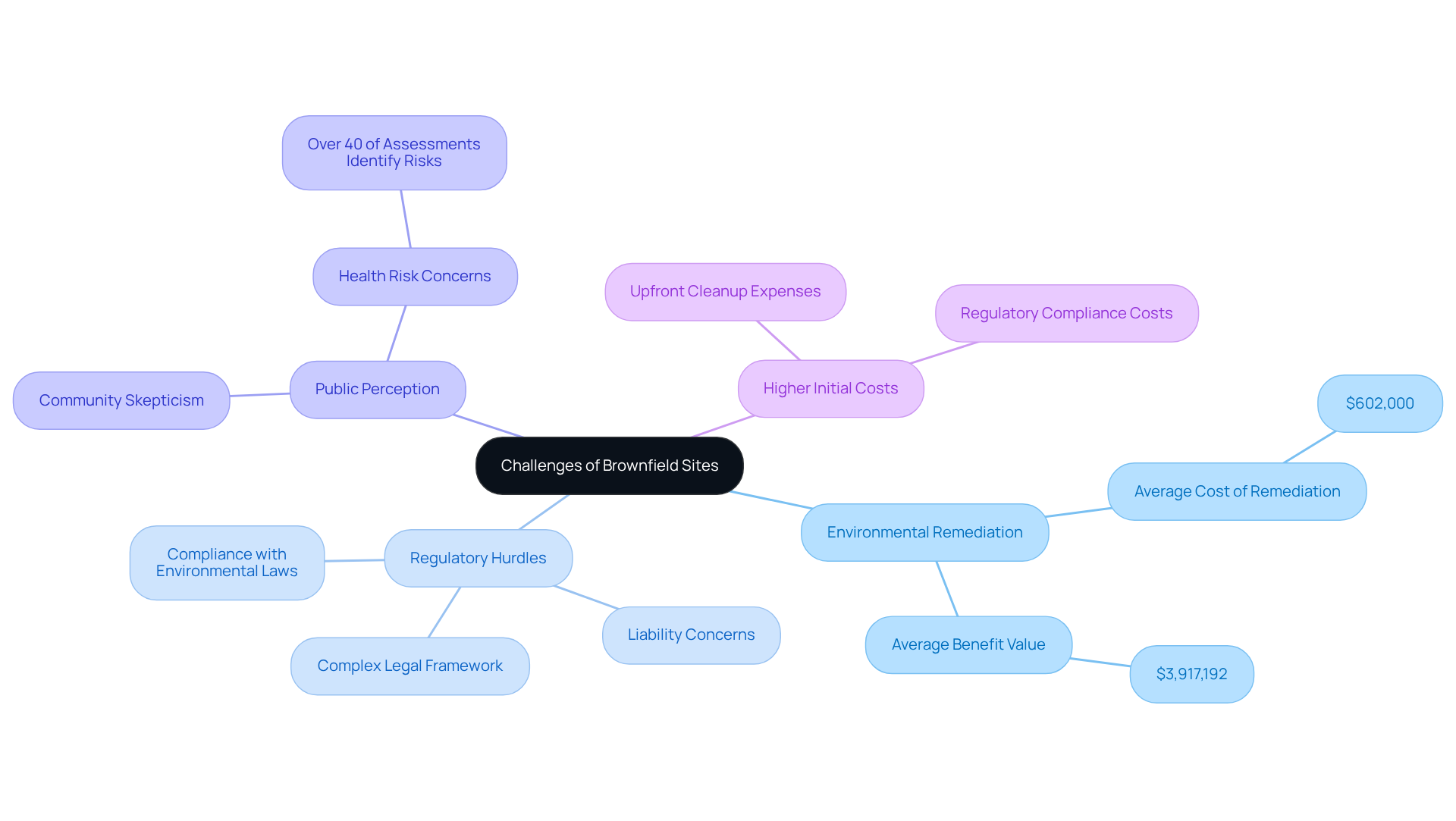
Compare Greenfield and Brownfield Sites: A Side-by-Side Analysis
| Criteria | Greenfield Sites | Brownfield Sites | |------------------------------|---------------------------------------------------|---------------------------------------------------| | Definition | Undeveloped land, never built upon | Previously developed land, may require remediation | | Design Flexibility | High, allows for innovative designs | Limited by existing structures and regulations | | Initial Costs | Generally lower, with no remediation needed | Often higher due to cleanup and compliance costs | | Development Timeline | Typically faster due to fewer regulatory hurdles | Can be significantly longer, often 12 months more due to remediation and approvals | | Environmental Impact | Can lead to habitat destruction and urban sprawl | Helps reduce urban sprawl and revitalizes areas | | Infrastructure Access | May require new infrastructure investments | Often benefits from existing infrastructure | | Government Incentives | Limited incentives for new development | Frequently eligible for grants and tax credits | | Current Trends | Increasing preference for sustainable development | Growing interest in revitalization and community benefits | | Decision-Making Factors | Lower initial costs and faster timelines are key | Potential for economic recovery, job creation, and community revitalization are crucial | | Return on Investment | Higher return on investment at 9.5% | Lower return on investment at 2.9% | | Expert Insight | "Based on the results, it is more advantageous to allocate the investment capital to the greenfield as the return on investment of the project expressed as a percentage of the average annual profit was 9.5%, compared to brownfield with only 2.9%." - Henrieta Pavolová | | Challenges | N/A | Environmental contamination and unclear property rights pose significant challenges. | | Public Support | N/A | Public interventions are necessary for effective revitalization efforts. |
This comparative analysis elucidates the distinct characteristics of greenfield and brownfield sites, empowering stakeholders to make informed decisions aligned with their specific project needs and goals. The choice between these sites fundamentally hinges on factors such as design flexibility, initial costs, potential for government incentives, and broader economic implications, including job creation and community revitalization, which are critical in the greenfield and brownfield site comparison. As the landscape of land acquisition evolves, comprehending these dynamics is essential for successful project execution.
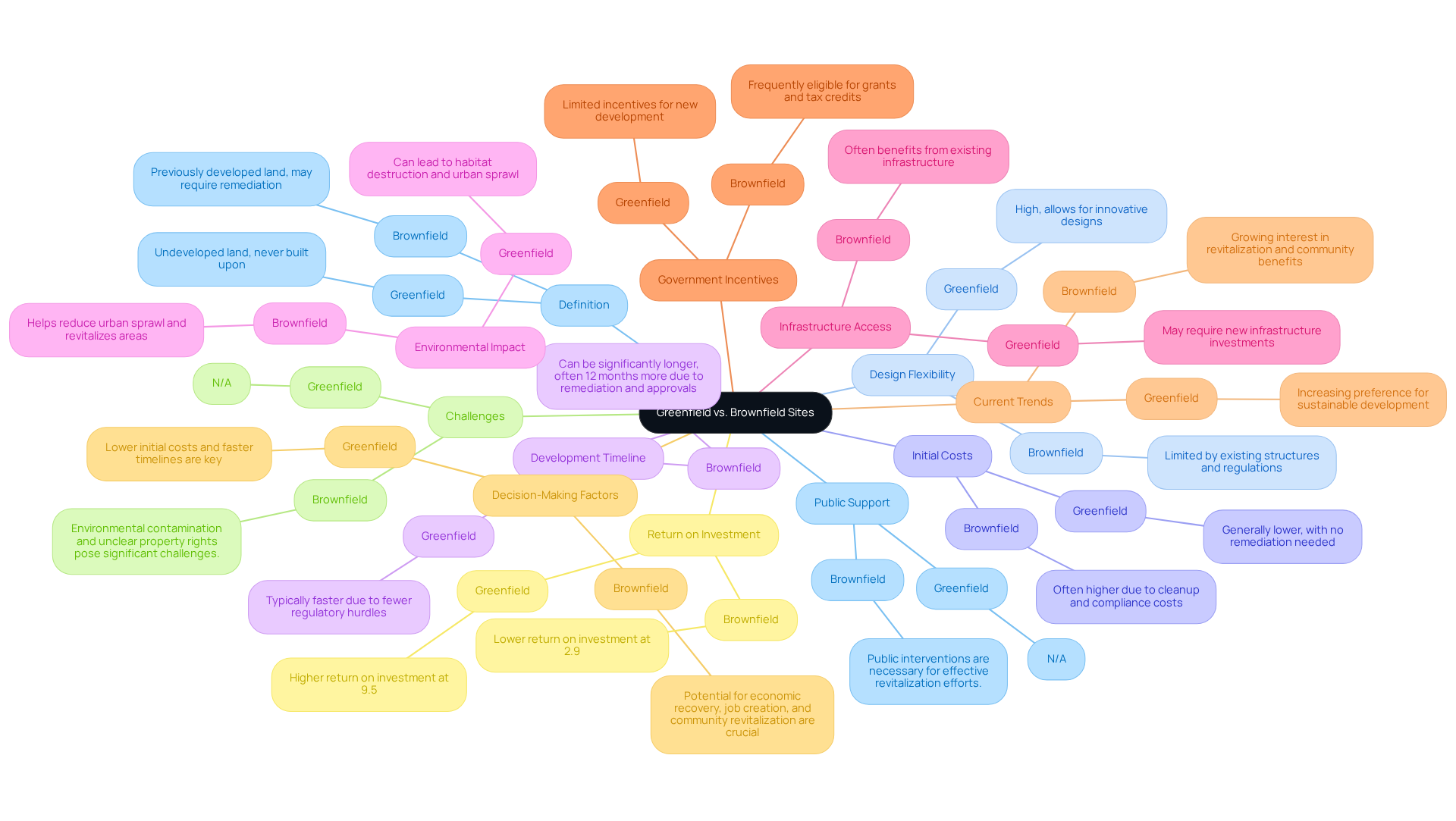
Conclusion
The exploration of greenfield and brownfield sites unveils a complex landscape, with each option presenting distinct advantages and challenges that significantly influence development strategies. Understanding the nuances of these site types is crucial for stakeholders aiming to make informed decisions that align with economic viability and environmental sustainability.
Greenfield sites offer unparalleled design flexibility and lower initial costs, making them attractive for new developments, particularly in rapidly growing markets. However, they also pose environmental risks, including habitat destruction and increased carbon emissions. Conversely, brownfield sites provide opportunities for urban revitalization and economic incentives, albeit with the burden of remediation costs and regulatory complexities. This comparative analysis underscores that while greenfield projects may yield faster returns, brownfield redevelopment can foster long-term community benefits and sustainability.
Ultimately, the choice between greenfield and brownfield sites should be guided by a careful consideration of project goals, community needs, and environmental implications. As urban landscapes continue to evolve, embracing a balanced approach that leverages the strengths of both site types will be essential in fostering sustainable growth and enhancing the quality of life for future generations. Stakeholders are encouraged to weigh these factors thoughtfully, ensuring that their decisions contribute positively to both economic development and environmental stewardship.
Frequently Asked Questions
What are greenfield sites?
Greenfield sites are undeveloped lands that have never been constructed upon, typically featuring natural landscapes like fields, forests, or agricultural areas. They provide significant design flexibility and generally face fewer regulatory hurdles.
What are brownfield sites?
Brownfield sites are previously developed areas that may contain pollutants or are underutilized, often located in urban environments. Redeveloping these sites involves remediation efforts and complex legal and environmental considerations.
What are the advantages of developing greenfield sites?
The advantages of greenfield sites include design flexibility, reduced initial expenses due to the lack of remediation needs, accelerated development schedules, and access to modern infrastructure, which allows for the incorporation of the latest technologies and sustainable practices.
How do greenfield sites compare to brownfield sites in terms of costs?
Greenfield sites typically have lower upfront costs compared to brownfield sites, as they do not require extensive cleanup efforts, which can be costly.
Why are greenfield sites preferred for new developments?
Greenfield sites are preferred for new developments due to their design flexibility, lower initial expenses, faster development timelines, and the ability to integrate modern infrastructure and sustainable practices from the outset.
What economic benefits do greenfield projects provide?
Greenfield projects can invigorate local economies through job creation, infrastructure enhancement, and increased tax revenue, while also delivering essential services and amenities to communities.
What environmental concerns are associated with greenfield developments?
Potential environmental concerns linked to greenfield developments include habitat destruction, pollution, greenhouse gas emissions, and the strain on natural resources.
List of Sources
- Define Greenfield and Brownfield Sites
- Greenfield versus Brownfield: The Experts Weigh In | News & Insights | Gray (https://gray.com/insights/greenfield-versus-brownfield-the-experts-weigh-in)
- Greenfield and Brownfield Sites: What is the difference? (https://aeroqual.com/blog/brownfield-vs-greenfield-sites)
- Land Take Regulations to Drive Land Prices, Density & Brownfield Developments Up | AEW (https://aew.com/research/land-take-regulations-to-drive-land-prices-density-brownfield-developments-up)
- Land use change statistics – new residential addresses 2021 to 2022 statistical release (https://gov.uk/government/statistics/land-use-change-statistics-2021-to-2022/land-use-change-statistics-new-residential-addresses-2021-to-2022)
- Explore the Advantages of Greenfield Sites
- What are the advantages of building on a greenfield site? | Herts Tools Co (https://hertstools.co.uk/what-are-the-advantages-of-building-on-a-greenfield-site)
- Greenfield vs. Brownfield Data Centers: The Strategic Decision Defining The Next Decade (https://blog.purestorage.com/purely-educational/greenfield-vs-brownfield-data-centers)
- Greenfield Development 101 (https://numberanalytics.com/blog/greenfield-development-101)
- Advantages and Disadvantages of greenfield sites (https://getrevising.co.uk/grids/advantages-and-disadvantages-of-greenfield-sites)
- Greenfield vs. Brownfield: What’s Better for Your Manufacturing Facility? | News & Insights | Gray (https://gray.com/insights/greenfield-vs-brownfield-whats-better-for-your-manufacturing-facility)
- Examine the Disadvantages of Greenfield Sites
- An Economic Analysis of Brownfield and Greenfield Industrial Parks Investment Projects: A Case Study of Eastern Slovakia - PMC (https://pmc.ncbi.nlm.nih.gov/articles/PMC8038097)
- What is a Greenfield Site: Everything You Need to Know - Hy-Tek Intralogistics (https://hy-tek.com/resources/what-is-a-greenfield-site-everything-you-need-to-know)
- 15 Inspirational Quotes On The Environment | EcoMENA (https://ecomena.org/inspirational-quotes-environment)
- Advantages and Disadvantages of greenfield sites (https://getrevising.co.uk/grids/advantages-and-disadvantages-of-greenfield-sites)
- Quotations about the Environment | US EPA (https://epa.gov/history/quotations-about-environment)
- Identify the Benefits of Brownfield Sites
- The Evolution of Brownfield Redevelopment (https://jsheld.com/insights/articles/the-evolution-of-brownfield-redevelopment)
- Navigating the Complexities of Urban Brownfield Redevelopment (https://numberanalytics.com/blog/navigating-brownfield-redevelopment-complexities)
- Brownfields Program Environmental and Economic Benefits | US EPA (https://19january2021snapshot.epa.gov/brownfields/brownfields-program-environmental-and-economic-benefits)
- Assess the Challenges of Brownfield Sites
- The Role of Brownfields in Economic Development: Turning Challenges into Opportunities (https://burr.com/newsroom/articles/the-role-of-brownfields-in-economic-development-turning-challenges-into-opportunities)
- Study Shows Substantial ROI on EPA’s Brownfield Cleanup Efforts (https://urbanland.uli.org/sustainability/study-shows-substantial-roi-epas-brownfield-grant-program)
- Student Corner: Primer on Brownfields Redevelopment | Community and Economic Development - Blog by UNC School of Government (https://ced.sog.unc.edu/2015/01/primer-on-brownfields-redevelopment)
- An Overview of Brownfields Redevelopment in the United States Through Regulatory, Public Health, and Sustainability Lenses - PMC (https://pmc.ncbi.nlm.nih.gov/articles/PMC10191173)
- Brownfield land and health: A systematic review of the literature - PMC (https://pmc.ncbi.nlm.nih.gov/articles/PMC10403084)
- Compare Greenfield and Brownfield Sites: A Side-by-Side Analysis
- Greenfield & Brownfield industrial parks Russia 2023| Statista (https://statista.com/statistics/1154696/greenfield-and-brownfield-industrial-parks-russia)
- Greenfield vs. Brownfield: What’s Better for Your Manufacturing Facility? | News & Insights | Gray (https://gray.com/insights/greenfield-vs-brownfield-whats-better-for-your-manufacturing-facility)
- An Economic Analysis of Brownfield and Greenfield Industrial Parks Investment Projects: A Case Study of Eastern Slovakia (https://mdpi.com/1660-4601/18/7/3472)




